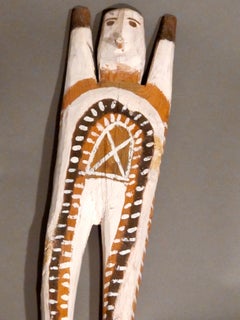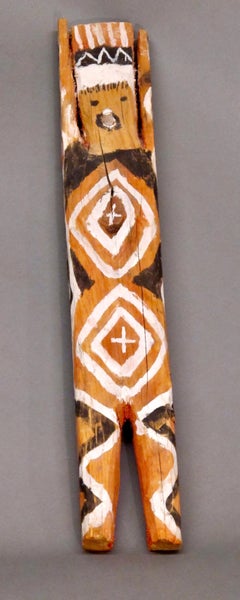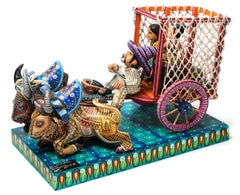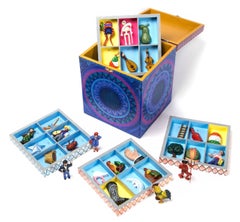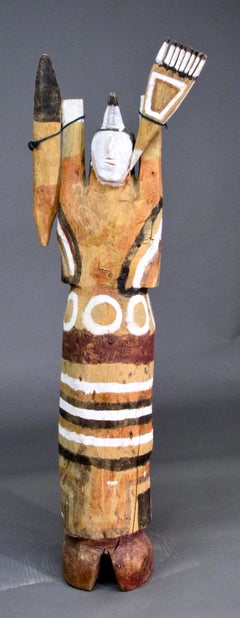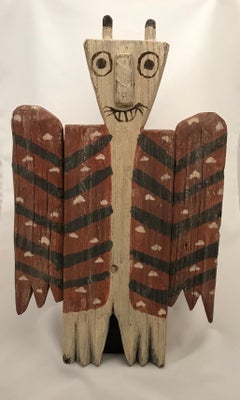Charlie Willeto Art
American, 1897-1964
Charlie Willeto was an artist known for his ritualist figures of human and animal forms that carry the potency of the Navajo spirit while transcending to the realm of the mythic. He is an artist who took up carving late in his life and found himself at the forefront of Navajo folk artists.
to
2
2
2
2
Untitled Figure with X on Chest by Charlie Willeto, Navajo Folk Art, wood, paint
By Charlie Willeto
Located in Santa Fe, NM
Untitled Figure with X on Chest by Charlie Willeto, Navajo Folk Art, wood, paint
Vintage
Category
1960s Folk Art Charlie Willeto Art
Materials
Wood, Paint
Navajo Folk Art Figure, Charlie Willetto, Native American Orange White Effigy
By Charlie Willeto
Located in Santa Fe, NM
Navajo Folk Art Figure, Charlie Willetto, Native American Orange White Effigy Vintage
Navajo medicine man Charlie Willeto (1897-1964) was also an art...
Category
1960s Charlie Willeto Art
Materials
Wood
Related Items
Carreta Herencia de mi Tierra / Wood carving Alebrije Mexican Folk Art Sculpt
By Manuel Cruz Prudencio
Located in Jesus del Monte, MX
FREE SHIPPING TO WORLDWIDE!
Artisan: Manuel Cruz Prudencio
MASTERPIECE
Made with Copal wood, woodcarving technique gouges, machete and sandpaper, decorated with acrylic paintings ...
Category
2010s Folk Art Charlie Willeto Art
Materials
Wood, Acrylic
$2,063 Sale Price
24% Off
H 13 in W 19 in D 11 in
8" Loteria Purpura / Wood carving Mexican Folk Art Sculpture
By Roxana y Jesus Hernandez
Located in Jesus del Monte, MX
FREE SHIPPING TO WORLDWIDE!
Artisan: Roxana y Jesus Hernandez
MASTERPIECE
Made with Copal wood, woodcarving technique gouges, machete and sandpaper, decorated with acrylic paintin...
Category
2010s Folk Art Charlie Willeto Art
Materials
Wood, Acrylic
$2,400
H 9 in W 8 in D 9 in
24'' Nativity Avion Wood carving Alebrije Sculpture Mexican Folk Art
By Agustin Cruz Tinoco
Located in Jesus del Monte, MX
FREE SHIPPING TO WORLDWIDE!
Artisan: Agustin Cruz Tinoco
MASTERPIECE:
Made with Copal wood, woodcarving technique gouges, machete and sandpaper, decorated with acrylic paintings wi...
Category
2010s Folk Art Charlie Willeto Art
Materials
Wood, Acrylic
$2,400
H 24 in W 20 in D 18 in
Aguila - Eagle - Mexican Folk Art Cactus Fine Art
By Manuel Cruz Prudencio
Located in Jesus del Monte, MX
Aguila - Eagle Alebrije
This Mexican Aguila - Eagle Alebrije made with Copal wood, wood carving technique gouges, machete and sandpaper, decorated with acrylic paintings with Zapotec symbols.
At Cactus Fine Art...
Category
2010s Folk Art Charlie Willeto Art
Materials
Wood, Acrylic
$2,100
H 6 in W 16 in D 8 in
Frida Espectacular - Amazing Frida - Mexican Folk Art Cactus Fine Art
By Taller Alfonso Castillo Orta
Located in Jesus del Monte, MX
Frida Espectacular - Amazing Frida
Made with natural clay and polychrome painting. Hand-modeled technique and cooked in an oven.
LISTING
===================================
1 Ceramic Frida
===================================
DETAILS
===================================
Time of Preparation: 2.5 months
Made: Izuca de Matamoros, Puebla, México.
Dimensions: 12" x 16" x 6" in or 30x 40" x 15 cm
Artisan: Taller Alfonso Castillo Orta...
Category
2010s Folk Art Charlie Willeto Art
Materials
Ceramic, Acrylic
$1,400
H 16 in W 12 in D 6 in
21" La vuelta al mundo Woodcarving Alebrije Sculpture Mexican Folk Art
By Zeny Fuentes Mendez
Located in Jesus del Monte, MX
FREE SHIPPING TO WORLDWIDE!
Artisan: Zeny Fuentes Mendez
MASTERPIECE
Made with Copal wood, woodcarving technique gouges, machete and sandpaper, decorated with acrylic paintings with...
Category
2010s Folk Art Charlie Willeto Art
Materials
Wood
$2,100 Sale Price
30% Off
H 12 in W 21 in D 7 in
Set Of 5 Plaster Framed Reliefs Of Romans 19th Century Grand Tour StyleItalian
Located in Roma, IT
A Grand Tour collection of five plaster reliefs depicting profiles of Julius Caesar, Agrippina, and the Roman emperors Vitellius, Otho, and Vespasian. Mounted in black frames against...
Category
19th Century Other Art Style Charlie Willeto Art
Materials
Fabric, Plaster, Wood
$4,112
H 11.03 in W 11.03 in D 1.58 in
Pato / Wood carving Lacquer Sculpture Mexican Folk Art
By Juan Zeferino Rivera
Located in Jesus del Monte, MX
FREE SHIPPING TO WORLDWIDE!
Artisan: Juan Zeferino Rivera
MASTERPIECE (Award Prize in Temalacatzingo 2016)
Made with Tzomplantli wood, woodcarving technique gouges, machete and sa...
Category
2010s Folk Art Charlie Willeto Art
Materials
Wood, Lacquer
$1,300
H 14 in W 24 in D 12 in
"Be Yourself" Decorative Monochromatice Abstract Figurative Clay Sculpture
Located in East Quogue, NY
Yeonsoo Kim, "Be Yourself," Monochromatic black and white clay vessel, White stoneware, black underglaze, 11.5 × 12.5 × 13 inches.
Korean ceramic artist Yeonsoo Kim masterfully blen...
Category
Early 2000s Outsider Art Charlie Willeto Art
Materials
Stoneware, Underglaze
$1,800
H 11.5 in W 12.5 in D 13 in
23'' El Autobus / Wood carving Lacquer Mexican Folk Art
By Meliton Zeferino Acevedo
Located in Jesus del Monte, MX
FREE SHIPPING TO WORLDWIDE!
Artisan: Meliton Zeferino Acevedo
Made with Tzomplantli wood, woodcarving technique gouges, machete and sandpaper, decorated with traditional lacquer ba...
Category
2010s Folk Art Charlie Willeto Art
Materials
Wood, Lacquer
$1,000
H 23 in W 22 in D 10 in
16'' Santa Claus Nacimiento / Wood carving Lacquer Sculpture Mexican Folk Art
By Juan Zeferino Rivera
Located in Jesus del Monte, MX
FREE SHIPPING TO WORLDWIDE!
Artisan: Juan Zeferino Rivera
MASTERPIECE (Award Prize in Temalacatzingo 2016)
Made with Tzomplantli wood, woodcarving technique gouges, machete and sa...
Category
2010s Folk Art Charlie Willeto Art
Materials
Wood, Lacquer
$1,200
H 19 in W 16 in D 11 in
Cangrejo / Wood carving Lacquer Sculpture Mexican Folk Art
By Juan Zeferino Rivera
Located in Jesus del Monte, MX
FREE SHIPPING TO WORLDWIDE!
Artisan: Juan Zeferino Rivera
MASTERPIECE
Made with Tzomplantli wood, woodcarving technique gouges, machete and sandpaper, decorated with traditional ...
Category
2010s Folk Art Charlie Willeto Art
Materials
Wood, Lacquer
$1,100
H 10 in W 28 in D 20 in
Previously Available Items
Standing Navajo Weaver with Weaving Tools, Charlie Willeto Wood paint Folk Art
By Charlie Willeto
Located in Santa Fe, NM
Standing Navajo Weaver with Weaving Tools, Wood paint Folk Art Charlie Willetto
Navajo medicine man Charlie Willeto (1897-1964) was also an artist--know...
Category
1960s Folk Art Charlie Willeto Art
Materials
Wood, Paint
Owl, Navajo Folk art, rustic, red, white, hearts, Santa Fe
By Charlie Willeto
Located in Santa Fe, NM
Navajo medicine man Charlie Willeto (1897-1964) was also an artist--known for his ritualist figures of human and animal forms that carry the potency of...
Category
1960s Folk Art Charlie Willeto Art
Materials
Wood, Paint
Charlie Willeto art for sale on 1stDibs.
Find a wide variety of authentic Charlie Willeto art available for sale on 1stDibs. You can also browse by medium to find art by Charlie Willeto in wood, paint and more. Not every interior allows for large Charlie Willeto art, so small editions measuring 4 inches across are available. Customers who are interested in this artist might also find the work of Curtis Jeré, Fidel Martinez Martinez, and Branko Bahunek. Charlie Willeto art prices can differ depending upon medium, time period and other attributes. On 1stDibs, the price for these items starts at $3,200 and tops out at $12,000, while the average work can sell for $7,100.
